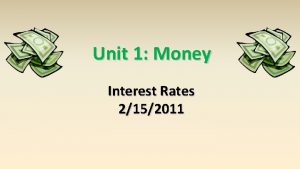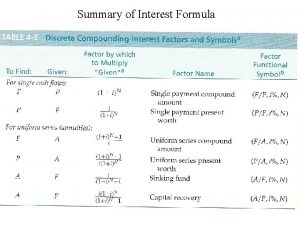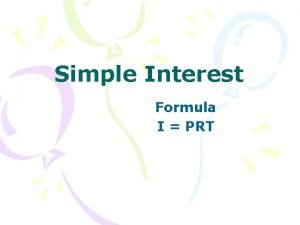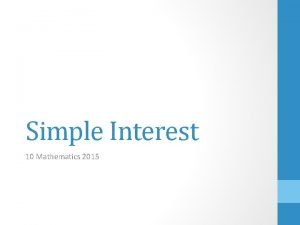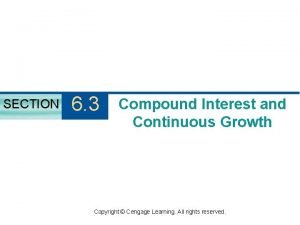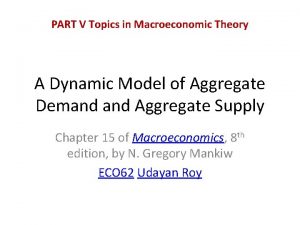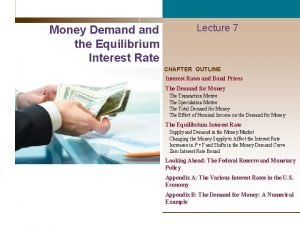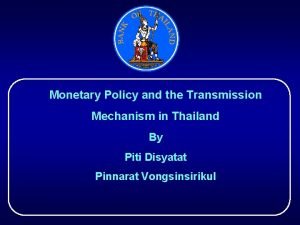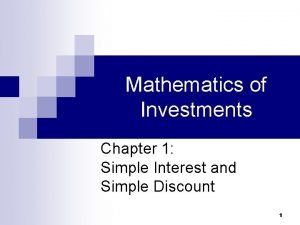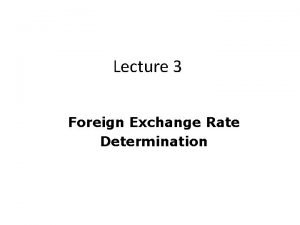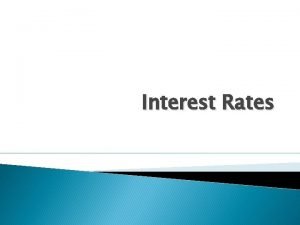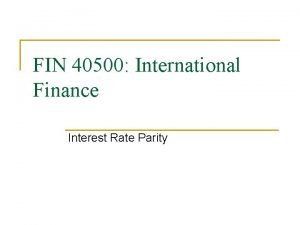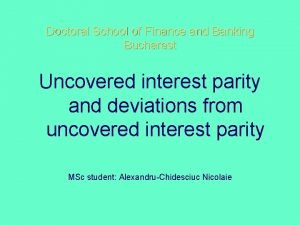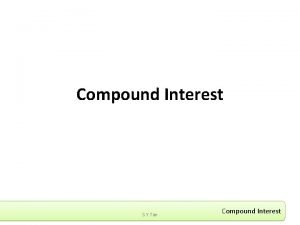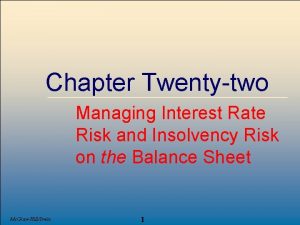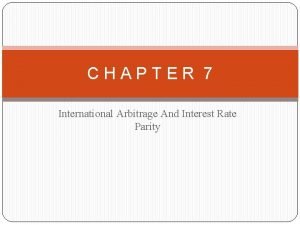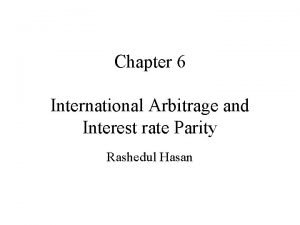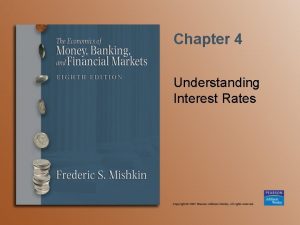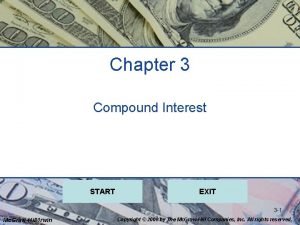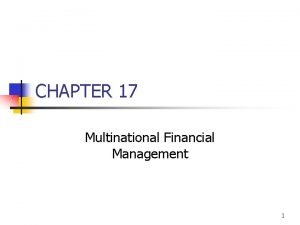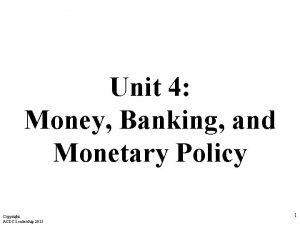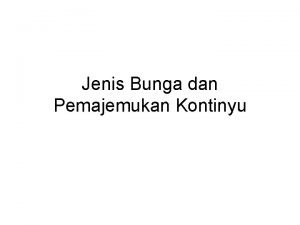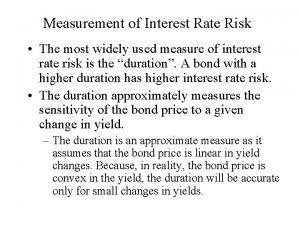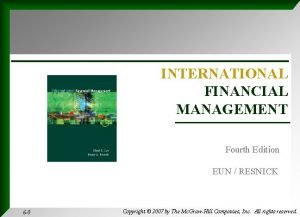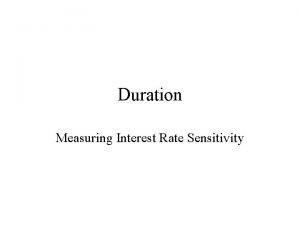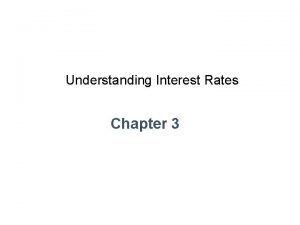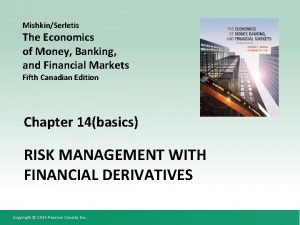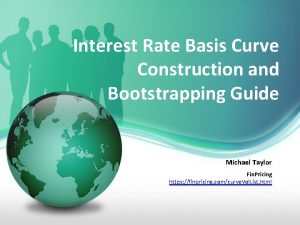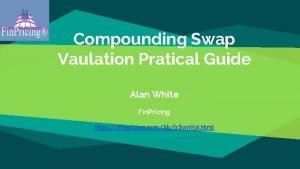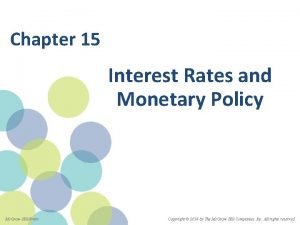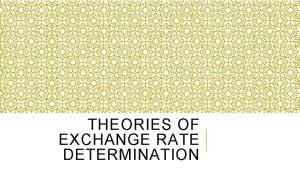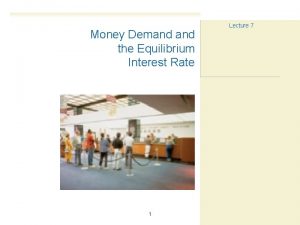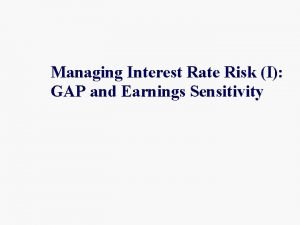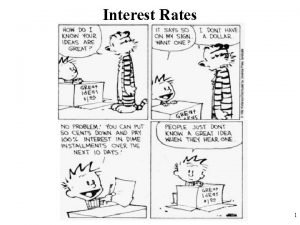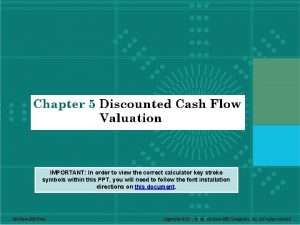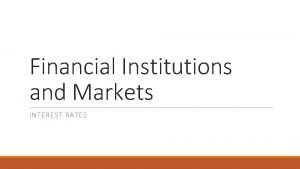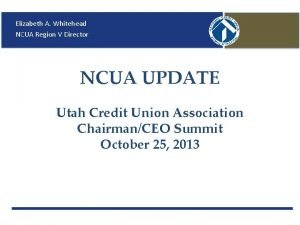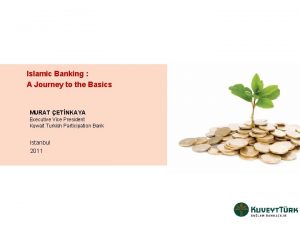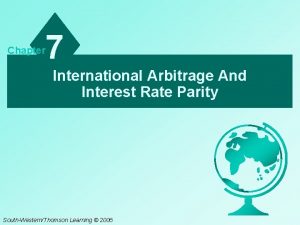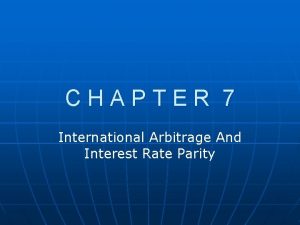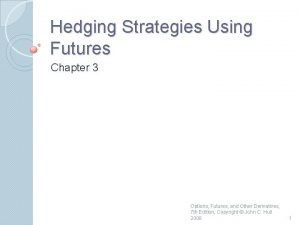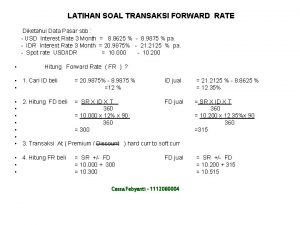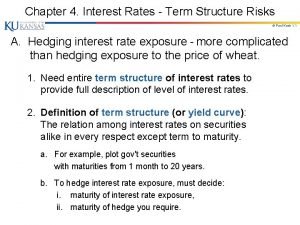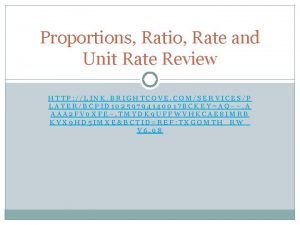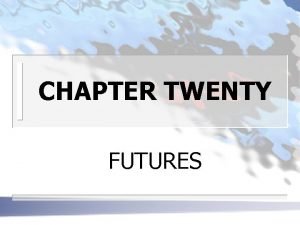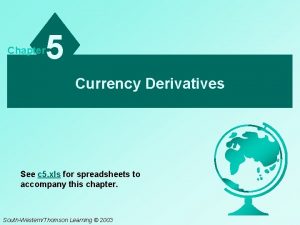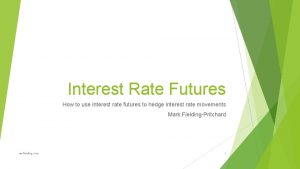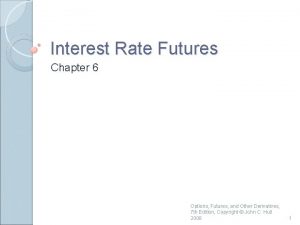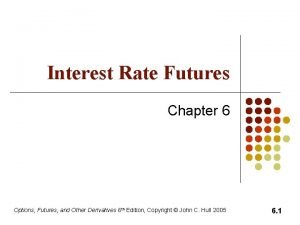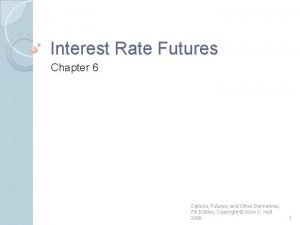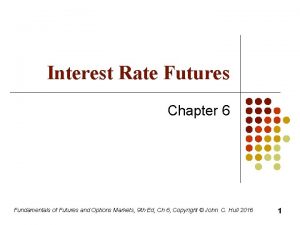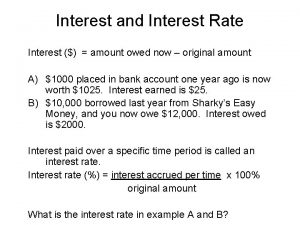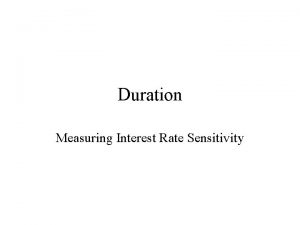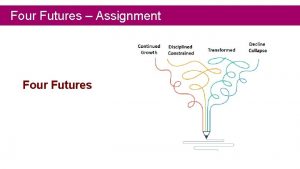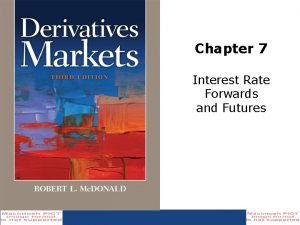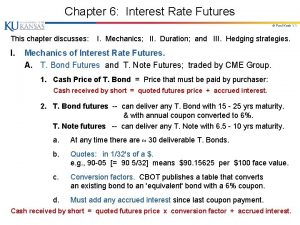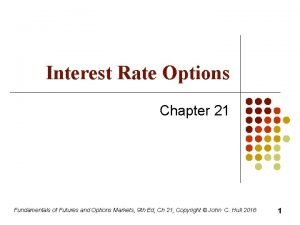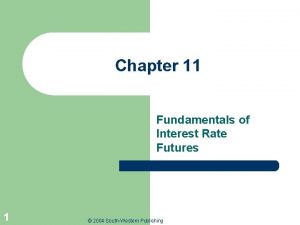CHAPTER 7 INTEREST RATE FUTURES In this chapter









































































- Slides: 73

CHAPTER 7 INTEREST RATE FUTURES In this chapter, we explore one of the most successful innovations in the history of futures markets; that is, interest rate futures contracts. This chapter is organized into the following sections: 1. Interest Rate Futures Contracts 2. Pricing Interest Rate Futures Contracts 3. Speculating With Interest Rate Futures Contracts 4. Hedging With Interest Rate Futures Contracts Chapter 7 1

Interest Rate Futures Introduction Interest rate futures contracts are one of the most successful innovations in futures trading. Pioneered in the United States, they have expanded internationally with strong presence in Great Britain and Singapore. The CBOT specializes in contracts with long-term maturity (e. g. , 2 -year, 5 -year and 10 -year T-notes, and 5 -year LIBOR-based swaps). The CME International Monetary Market (IMM) specializes in contracts with short-term maturity (e. g. , 1 -month, and 3 month Eurodollar deposits). Chapter 7 2

Short-Term Interest Rates Contracts In this section, four short-term interest rate futures contracts will be examined: 1. Eurodollar Futures 2. Euribor Futures 3. TIEE 28 Futures 4. Treasury Bill Futures Chapter 7 3

Eurodollar Futures Product Profile Chapter 7 4

Eurodollar Futures 1. Eurodollar futures currently dominate the U. S. market for short-term futures contracts. 2. Rates on Eurodollar deposits are usually based on LIBOR (London Interbank Offer Rate). – LIBOR is the rate at which banks are willing to lend funds to other banks in the interbank market. 3. Eurodollars are U. S. dollar denominated deposits held in a commercial bank outside the U. S. 4. The Eurodollar contracts is for $1, 000. 5. A Eurodollar futures contract is based on a time deposit held in a commercial bank (e. g. , 3 -month Eurodollar) 6. Eurodollar contracts are non-transferable. Chapter 7 5

Eurodollar Futures 7. Eurodollar futures were the first contract to use cash settlement rather than delivery of an actual good for contract fulfillment. 8. To establish the settlement rate at the close of trading, the IMM determines the three-month LIBOR rate. 9. This settlement rate is then used to compute the amount of the cash payment that must be made. 10. The yield on the Eurodollar contract is quoted on an add-on basis as follows: Chapter 7 6

Eurodollar Add-on Yield In order to calculate the add-on yield, the price and discount must be computed as follows: Or equivalently Chapter 7 7

Eurodollar Add-on Yield Suppose you have a 90 -day Eurodollar deposit with a discount yield of 8. 32%. Step 1: Compute the discount and the price. Chapter 7 8

Eurodollar Add-on Yield Step 2: Compute the add-on yield using: A one basis point change in the Add-on Yield, on a 3 -month Eurodollar contract implies a $25 change in price. This amount can be compute using: Eurodollar futures contract prices are quoted using the IMM Index which is a function of the 3 -month LIBOR rate: IMM Index = 100. 00 - 3 -Month LIBOR Chapter 7 9

Euribor Futures Euribors are Eurodollar time deposits. Swaps dealers use Euribor futures to hedge the risk resulting from their activities. Euribor futures are traded at: Euronex. liffe – Contracts are based on a 3 -month time deposit with a € 1, 000 notional value. – Contracts are cash settled at expiration. Eurex – Contracts are based on a 3 -month time deposit with a € 3, 000 notional value. – Contracts are cash-settled at expiration. Chapter 7 10

Euribor Futures Product Profile Chapter 7 11

TIEE 28 Futures The TIEE 28 futures contract is based on the short-term (28 -day) Mexican interest rate. The contract is traded on the Mexican Derivatives Exchange (Mercado Mexicano de Derivados, or Mex. Der) A 28 -day TIIE futures contract has a face value of 100, 000 Mexican pesos. The contract is cash settled based on the 28 -day Interbank Equilibrium Interest Rate (TIIE), calculated by Banco de México. Chapter 7 12

TIEE 28 Futures Chapter 7 13

Treasury Bill Futures 1. A T-bill is the U. S. government borrowing money for a short period of time. – Treasury bills have original maturities of 13 weeks and 26 weeks. 2. The Treasury bill futures contract calls for the delivery of T-bills having a face value of $1, 000 and a time to maturity of 90 days at the expiration of the futures contract. – 91 -day and 92 day T-bills may also be delivered with a price adjustment. – The contracts have delivery dates in March, June, September, and December. – The delivery dates are chosen to make newly issued 13 week T-bills immediately deliverable against the futures contract. Chapter 7 14

Treasury Bill Futures Price quotations for T-bill futures use the International Monetary Market Index (IMM). IMM Index = 100 - DY Where: DY = Discount Yield Example A discount Yield of 7. 1% implies an IMM Index of: IMM Index = 100 - 7. 1 IMM Index = 92. 9 Chapter 7 15

Treasury Bill Futures Recall that a bill with 90 days to maturity and a 8. 32% discount yield, has a price of $979, 200 and a $discount of $20, 800. For a futures contract with a discount yield of 8. 32%, the price to be paid for the T-bill at delivery would be $979, 200. A one basis point shift implies a $25 change on a $1, 000, 3 -month futures contract. If the futures yield rose to 8. 35%, the delivery price would be $979, 125. Chapter 7 16

Other Short-Term Interest Rate Futures Insert Figure 7. 1 here Chapter 7 17

Longer-Maturity Interest Rate Futures Longer-maturity interest rate futures are based on couponbearing debt instruments as the underlying good. These instruments require the delivery of an actual bond. In this section, long-term interest rate futures contracts will be examined, including: 1. Treasury Bond Futures 2. Treasury Note Futures 3. Non-US Longer Maturity Interest Rate Futures Chapter 7 18

Treasury Bond Futures Traded at the CBOT, the Treasury bond futures contract is one of the most successful futures contracts. Requires the delivery of T-bonds with a $100, 000 face value and with at least 15 years remaining until maturity or until their first permissible call date. T-bond contracts trade for delivery in March, June, September, and December. Delivery against the T-bond contract is a several day process that the short trader can trigger to cause delivery on any business day of the delivery month. – First Position Day First permissible day for the short to declare his/her intentions to make delivery, with delivery taking place 2 business days later. – Position Day Short declares his/her intentions to make delivery. This may occur on the first position day or some other later day. Delivery Day Clearinghouse matches the short and long traders and requires them to fulfill their responsibilities. Chapter 7 19

Treasury Bond Futures Price Quotation for Major Interest Rate Futures Contracts Insert Figure 7. 1 Here Chapter 7 20

Treasury Bond Futures Delivery Process Insert Figure 7. 2 here Chapter 7 21

Treasury Bond Futures Product Profile Chapter 7 22

Treasury Bond Futures Conversion Factor The T-bond contract does not specify exactly which bond must be delivered to fulfill the futures contract. Rather, a number of different bonds can be delivered to fulfill the futures contract. Because the short trader chooses whether to make delivery, and which bond to deliver, the short trader will want to deliver the bond that is least expensive for him/her to obtain. This bond is called the cheapest-to-deliver bond. To address this issue, a conversion factor is computed to equate the bonds. Chapter 7 23

Treasury Bond Futures Conversion Factor Where: DSP = Decimal Settlement Price (The decimal equivalent of the quoted price) CF = Conversion Factor (the conversion factor as provided by the CBOT) AI = Accrued Interest (Interest that has accrued since the last coupon payment on the bond) This system is effective as long as the term structure of interest rates is flat and the bond yield is 6%. However, if the term structure of interest rates is not flat, or if bond yields are not 6%, some bonds will still be less expensive to deliver against the futures contract than others. Chapter 7 24

T-Bond and T-Notes Delivery Sequence Table 7. 1 shows key dates in the delivery process for Tbond and T-note futures contracts in 1997. Chapter 7 25

Treasury Bond Futures Conversion Factor Chapter 7 26

Treasury Note Futures Treasury note futures are a shorter maturity version of a Treasury bond. • T-note Futures are very similar to Treasury bond futures. • T-note futures contracts are available for 2 -year, 5 -year, and 10 -year maturities. Contract Size 2 -year contract $200, 000 5 -year & 10 year contract $100, 000 Deliverable Maturities 2 -year contract 21 -24 month 5 -year contract 4 yrs 3 mos. to 5 yrs 3 mos. 10 -year contract 6 yrs 6 mos. to 10 years Chapter 7 27

CBOT’s 10 -Year Treasury Note Futures Product Profile Chapter 7 28

Non-US Long Maturity Interest Rate Futures Chapter 7 29

Pricing Interest Rate Futures Contracts Because, interest rate futures trade in a full carry market, the foundation for pricing interest rate futures is the Cost-of -Carry-Model that we discussed in Chapter 3. This section introduces a review of the Cost-of-Carry Model as discussed in Chapter 3, including: 1. Cost-of-Carry Rule 3 2. Cost-of-Carry Rule 6 3. Features that Promote Full Carry 4. Repo Rates 5. Cost-of-Carry Model in Perfect Market 6. Cash-and-Carry Arbitrage for Interest Rate Futures Chapter 7 30

Cost-of-Carry Rule 3 Recall: the cost-of-carry rule #3 says: Where: S 0 = The current spot price F 0, t = The current futures price for delivery of the product at time t C 0, t= The percentage cost required to store (or carry) the commodity from today until time t Chapter 7 31

Cost-of-Carry Rule 6 Recall: the cost-of-carry rule #6 says: F 0, d = the futures price at t=0 for the distant delivery contract maturing at t=d Fo, n= the futures price at t=0 for the nearby delivery contract maturing at t=n Cn, d= the percentage cost of carrying the good from t=n to t=d Chapter 7 32

Full Carry Features Recall from Chapter 3 that there are five features that promote full carry: 1. Ease of Short Selling 2. Large Supply 3. Non-Seasonal Production 4. Non-Seasonal Consumption 5. High Storability Interest rates futures have each of these features and thus conform well to the Cost-of-Carry Model. Chapter 7 33

Repo Rate Recall from Chapter 3 that if we assume that the only carrying cost is the financing cost, we can compute the implied repo rate as: or Interest rate futures conform almost perfectly to the Costof-Carry Model. However, we must take into account some of the peculiar aspects of debt instruments. Chapter 7 34

Cost-of-Carry Model in Perfect Market Assumptions 1. Markets are perfect. 2. The financing cost is the only cost of carrying charge. 3. Ignore the options that the seller may possess such as the option to deliver differing securities. 4. Ignore the differences between forward and futures prices. Chapter 7 35

Cash-and-Carry Arbitrage for Interest Rate Futures Recall from Chapter 3 that in order to earn an arbitrage profit, a trader might want to try a cash-and-carry arbitrage. Recall further that a cash-and-carry arbitrage involves selling a futures contract, buying the commodity and storing it until the futures delivery date. Then you would deliver the commodity against the futures contract. Applying the cash-and-carry arbitrage to interest rate futures requires careful selection of the commodity’s interest rate (T-bill, T-bond etc) that will be purchased. Each of the interest rate futures contracts specifies the maturity of the interest rate instrument to be delivered. The interest rate instrument must have this maturity on the delivery date. Chapter 7 36

Cash-and-Carry Arbitrage for Interest Rate Futures Example, a T-bill futures contract requires the delivery of a T-bill with 90 days to maturity on the delivery date. So, if you sell a T-bill futures contract that calls for delivery in 77 days, we must purchase a T-bill that will have 90 days to maturity, 77 days from today, in order to meet your obligations. That is, you must purchase a T-bill that has 167 days to maturity today. 0 77 1. Sell futures Contract. 2. Buy T-bill Futures contract w/ 167 days to maturity. 3. Deliver T-bill (that has now 90 days to maturity) against futures contract. 167 4. T-bill matures Table 7. 2 and 7. 3 further develop this example. Chapter 7 37

Cash-and-Carry Arbitrage for Interest Rate Futures Assume that markets are perfect including the assumption of borrowing and lending at a risk-less rate represented by the T-bill yields. Suppose that you have gathered the information in Table 7. 2 and wish to determine if an arbitrage opportunity is present. How was the bill price of $987, 167 from Table 7. 2 calculated? Chapter 7 38

Cash-and-Carry Arbitrage for Interest Rate Futures The bill prices were calculated as follows: For the March Futures Contract For the March 167 -day T-bill For the 77 -day T-bill with $1, 000 face value Chapter 7 39

Cash-and-Carry Arbitrage for Interest Rate Futures The transactions necessary to earn an arbitrage profit are given in Table 7. 3. How was the $966, 008 from Table 7. 3 calculated? Chapter 7 40

Cash-and-Carry Arbitrage for Interest Rate Futures The $966, 008 is the face value of a 77 -day T-bill with a current price of $953, 611. To calculate this value, rearrange the bill price formula: Rearranging the equation results: Chapter 7 41

Cash-and-Carry Arbitrage to Interest Rate Futures When delivery is due on the futures contract on March 22, you deliver the T-bill (which now has 90 days to maturity) against the futures contract. Combined, these transactions appear as follows on a timeline: 0 1 4. Deliver the T-bill against the futures contract 5. Pay off the loan 1. Borrow money 2. Buy 167 -day T-bill 3. Sell a futures contract Chapter 7 42

Reverse Cash-and-Carry Arbitrage to Interest Rate Futures Using the same values as shown in Table 7. 2, now assume that the rate on the 77 -day T-bill is 8%. Given this new information and Table 7. 2 prices, a reverse cash-and-carry arbitrage opportunity is present. Table 7. 4 shows the result. To calculate the values in Table 7. 4 follow the steps shown for the previous cash-and-carry example. Chapter 7 43

Reverse Cash-and-Carry Arbitrage to Interest Rate Futures Combined, these transactions appear as follows on a timeline: Jan 5 1. Borrow money 2. Buy 77 -day T-bill 3. Buy a futures contract Mar 22 4. Collect from maturing T-bill 5. Accept delivery on 90 -day contract Chapter 7 Jun 20 6. Collect 1 M from mature T-bill 7. Pay off loan 44

Interest Rate Futures Rate Relationships Rate relationship that must exist between interest rates to avoid arbitrage: Consider two methods of holding a T-bill for 167 days. Method 1: Buy a 167 day T-bill Method 2: Buy a 77 day T-bill. Buy a futures contract for delivery of a 90 day T-bill in 77 days. Use the futures contract to buy a 90 -day T-bill. These investment appear as follows on a timeline. Chapter 7 45

Interest Rate Futures Rate Relationships Method 1 Jan 5 Mar 22 1. Buy 167 -day T-bill Jun 20 2. Collect from maturing T-bill Method 2 Jan 5 1. Buy 77 -day T-bill 2. Buy a future contract for 90 -day T-bill w/ 77 days to maturity Mar 22 3. Collect from maturing T-bill 4. Buy a 90 -day T-bill using the futures contract Jun 20 5. Collect from maturing T-bill Either of these two methods of investing in T-bills has exactly the same investment and exactly the same risk. Since both investment have exactly the same risk and exactly the same investment, they must have exactly the same yield to avoid arbitrage. Chapter 7 46

Financing Cost and Implied Repo Rate Calculate the rate that must exist on the 77 -day T-bill to avoid the arbitrage as follows: Use the no arbitrage equation to determine the appropriate yield on the 77 -day T-bill by, using the following equation: Where: NA Yield = the no arbitrage Yield DTMFC = days to maturity of the futures contract Chapter 7 47

Financing Cost and Implied Repo Rate So in order for there to be no arbitrage opportunities available, the yield on the 77 day T-bill must be 7. 3063%. If the yield on the 77 day T-bill is greater than 7. 3063%, then engage in a reverse cash-and-carry arbitrage. If the yield on the 77 day T-bill is less than 7. 3063%, engage in a cash-and-carry arbitrage. Chapter 7 48

Financing Cost and Implied Repo Rate We can also calculate the implied repo rate as follows: In our case the spot price is the price of the 167 -day to maturity T-bill, so: The implied repo rate (C) is 1. 5875% The implied repo rate is the cost of holding the commodity for 77 days, between today and the time that the futures contract matures, assuming this is the only financing cost, it is also the cost of carry. Chapter 7 49

Financing Cost and Implied Repo Rate 1. If the implied repo rate exceeds the financing cost, then exploit a cash-and-carry arbitrage opportunity Borrow funds Buy cash bond Sell futures Realize profit Deliver against futures Hold bond 2. If the implied repo rate is less than the financing cost, then exploit a reverse cash-and-carry arbitrage. Buy futures Sell bond short Invest proceeds until futures exp. Realize profit Repay short sale obligation Take delivery Chapter 7 50

Cost-of-Carry Model for T-Bond Futures The cost of carry concepts for T-bill futures that we have just examined also apply to T-bond futures. However, the computation must be adjusted to reflect the coupon payment and accrued interests. Chapter 7 51

Cost-of-Carry Model in Imperfect Markets In this section, the borrowing and lending assumptions are relaxed, and the Cost-of-Carry Model is explored under the following assumption: 1. The borrowing rate exceeds the lending rate. 2. The financing cost is the only carrying charge. 3. Ignore the options that the seller may possess. 4. Ignore the differences between forward and futures prices. 5. Recall that allowing the borrowing and lending rates to differ leads to an arbitrage band around the futures price. Now assume that the borrowing rate is 25 basis points, or one-fourth of a percentage point, higher than the lending rate. Continuing to use our T-bill example. Chapter 7 52

Cash-and-Carry Strategy Notice that the entire arbitrage profit disappears when these differential borrowing and lending rates are considered. Chapter 7 53

Reserve Cash-and-Carry Transaction Again notice that the entire arbitrage profit disappears when these different borrowing and lending rates are considered. Chapter 7 54

A Practical Survey of Interest Rate Futures Pricing Recall from Chapter 3 that transaction costs lead to a noarbitrage band of possible futures prices. In essence, transaction costs increase the no-arbitrage band just as unequal borrowing and lending rates do. Impediments to short selling as a market imperfection would frustrate the reverse cash-and-carry arbitrage strategy. From a practical perspective, restrictions on short selling are unimportant in interest rate futures pricing because: – Supplies of deliverable Treasury securities are plentiful and government securities have little (or zero) convenience yield. – Treasury securities are so widely held, many traders can simulate short selling by selling T-bills, T-notes, or Tbonds from inventory. Therefore, restrictions on short selling are unlikely to have any pricing effect. Chapter 7 55

Speculating with Interest Rate Futures There are several ways that you can speculate with interest rate futures: 1. Outright Position. 2. Intra-Commodity T-Bill Spread 3. A T-bill/Eurodollar (TED) Spread 4. Notes over Bonds (NOB) Chapter 7 56

Speculating with Outright Position Two ways to speculate with outright positions are: 1. Purchase an interest rate futures contract: a bet that interest rates will go down. 2. Sell an interest rate futures contract: a bet that interest rates will go up. Suppose you think that interest rates will go up. The transactions necessary to bet on your hunch are outlined in Table 7. 80. Chapter 7 57

Speculating with Outright Position Interest rates have gone up as you predicted. Your profit (based on $25 per basis point contract) is: Profit = (Sell Rate – Buy Rate)($25) Profit = (90. 30 – 90. 12) = 0. 18 is 18 basis points, each of which implies a $25 change in contract value so: Profit = (Basis Points)(Value per Basis Point) Profit = (18)($25) = $450 Chapter 7 58

Intra-Commodity T-Bill Spread If you don’t know if rates will rise or fall, but do think that the shape of the yield curve will change, (that is the relationship between short term interest rates and long term interest rates will change) you might engage in an Intra-commodity T-bill spread. If you think that the spread will narrow (the yield curve will become flatter) you would buy the longer term contract and sell the shorter term contract. If you think that the spread will widen (the yield curve will become steeper), you would buy the shorter term contract and sell the longer term contract. Chapter 7 59

Intra-Commodity T-Bill Spread Suppose you have the following information (Table 7. 9) regarding T-bills and T-bill futures contracts for March 20. The left 2 columns are T-bills, and the right 3 columns are futures contracts. You think that the yield curve will flatten and wish to trade to make a profit. Chapter 7 60

Intra-Commodity T-Bill Spread Notice that the T-bills exhibit an upward sloping yield curve. Notice that the futures contract yields also exhibit and upward sloping yield curve. If the yield curve flattens, the yield spread between subsequent maturing futures contracts must narrow. That is, the difference between the yield on the December contract and on the September contract must narrow. Since you think that the spread will narrow (the yield curve will become flatter) you would buy the longer term contract and sell the shorter term contract, as it is demonstrated in Table 7. 10. Chapter 7 61

Intra-Commodity T-Bill Spread Gain in Basis Points Change in December Contract Change in September Contract 1. 64 -1. 52 Net Change in Positions 12 basis points Each Basis Point is worth $25 Profit Net Change in Positions Basis Point Value Profit 12 $25 $300 Chapter 7 62

T-Bill/Eurodollar (TED) Spread The TED spread is the spread between Treasury bill contracts and Eurodollar contracts. In theory, Treasury bills should always have a lower yield than Eurodollar deposits. T-bills are backed by the full taxing authority of the U. S. government. Eurodollar deposits are generally not backed by the respective governments. Thus, T-bills are a safer investment and as such, should pay a lower interest rate. Eurodollars are riskier and should pay a higher rate of interest. How much lower/higher? The amount of the difference depends upon world events. To the extent that the world situation is considered safe, the difference should be low. To the extent that the world situation is unsafe, the difference should be high. Table 7. 11 shows the transactions necessary to engage in a TED spread when you wish to bet that the spread will widen. Chapter 7 63

T-Bill/Eurodollar (TED) Spread Notice that the spread widened as the trader expected, allowing him/her to earn a $675 profit. Chapter 7 64

Notes over Bonds (NOB) The NOB is a speculative strategy for trading T-note futures against T-bond futures. NOB spreads exploit the fact that T-bonds underlying the T -bond futures contract have a longer duration than the Tnotes underlying the T-note futures contract. A given change in yields will cause a greater price reaction for the T-bond futures contract. Thus, the NOB spread is an attempt to take advantage of either changing levels of yields or a changing yield curve by using an inter-market spread. Chapter 7 65

Hedging with Interest Rate Futures There are several ways that you can hedge with interest rate futures, including: 1. Long Hedges 2. Short Hedges 3. Cross-Hedges Chapter 7 66

Hedging with Interest Rate Futures Recall that the goal of a hedger is to reduce risk, not to generate profits. Using interest rate futures to hedge involves taking a futures position that will generate a gain to offset a potential loss in the cash market. This also implies that a hedger takes a futures position that will generate a loss to offset a potential gain in the cash market. Chapter 7 67

Long Hedges On December 15, a portfolio manager learns that he will have $970, 000 to invest in 90 -day T-bills six months from now, on June 15. Current yields on T-bills stand at 12% and the yield curve is flat, so forward rates are all 12% as well. The manager finds the 12% rate attractive and decides to lock it in by going long in a T-bill futures contract maturing on June 15, exactly when the funds come available for investment as Table 7. 12 shows: Chapter 7 68

Long Hedges With current and forward yields on T-bills at 12 percent, the portfolio manager expects to be able to buy $1, 000 face -value of T-bills for $970, 000 because: On June 15, the 90 -day T-bill yield has fallen to 10%. Thus, the price of a 90 day T-bill is: Thus, if the manager were to purchase the T-bill in the market, he would be $5, 000 short. Chapter 7 69

Long Hedges The futures profit exactly offsets the cash market loss for a zero change in wealth. With the receipt of the $970, 000 that was to be invested, plus the $5, 000 futures profit, the original plan may be executed, and the portfolio manager purchases $1, 000 face value in 90 -day T-bills. Insert Figure 7. 7 here The idealized yield Curve Shit for the long Hedge. Chapter 7 70

Short Hedge Banks may wish to hedge their interest rate positions to lock in profits. Table 7. 13 demonstrates how a bank that makes a one million dollar fixed rate loan for 9 months, and can only finance the loan with 6 -month CDs, can hedged its position. Because the bank hedged, its profits were not affected by a change in interest rates. Chapter 7 71

Cross-Hedge Recall that a cross-hedge occurs when the hedged and hedging instruments differ with respect to: 1. Risk level 2. Coupon 3. Maturity 4. Or the time span covered by the instrument being hedged and the instrument deliverable against the futures contract. 5. To illustrate how a cross-hedge is conducted, assume that a large furniture manufacturer has decided to issue one billion 90 -day commercial paper in 3 months. Table 7. 14 illustrate the cross-hedge. Chapter 7 72

Cross-Hedge Chapter 7 73
 What is real interest rate and nominal interest rate
What is real interest rate and nominal interest rate Interest rate futures
Interest rate futures Interest rate futures
Interest rate futures Hedging interest rate risk with futures
Hedging interest rate risk with futures Cap rate interest rate relationship
Cap rate interest rate relationship Nominal.interest rate
Nominal.interest rate 0 965
0 965 Interest rate effect
Interest rate effect What is discrete compounding
What is discrete compounding I = prt formula
I = prt formula Time interest formula
Time interest formula How to write compound interest formula
How to write compound interest formula Nominal vs real return
Nominal vs real return Dad curve equation
Dad curve equation Effective monthly interest rate
Effective monthly interest rate Money demand and interest rate
Money demand and interest rate Interest rate transmission mechanism
Interest rate transmission mechanism Macroeconomics unit 5 lesson 2 activity 45
Macroeconomics unit 5 lesson 2 activity 45 P=i/rt
P=i/rt Absolute purchasing power parity
Absolute purchasing power parity Interest rates quotes
Interest rates quotes Interest parity
Interest parity Uncovered interest rate parity formula
Uncovered interest rate parity formula Interest rate compounded annually
Interest rate compounded annually Interest rate parity example
Interest rate parity example Interest rate duration
Interest rate duration International arbitrage
International arbitrage Locational parity
Locational parity Mora interest rate
Mora interest rate Interest rate compounded annually
Interest rate compounded annually Interest rate implicit in the lease formula
Interest rate implicit in the lease formula Multinational financial management requires that
Multinational financial management requires that Contractionary monetary policy
Contractionary monetary policy Effective monthly interest rate
Effective monthly interest rate Decreasing money supply
Decreasing money supply Rumus bunga majemuk kontinu
Rumus bunga majemuk kontinu Agdao multi purpose cooperative
Agdao multi purpose cooperative Measurement of interest
Measurement of interest Interest rate parity
Interest rate parity Interest rate risk sensitivity analysis
Interest rate risk sensitivity analysis Forward interest rate formula
Forward interest rate formula Forward interest rate formula
Forward interest rate formula Tahvilin piyasa değeri nasıl hesaplanır
Tahvilin piyasa değeri nasıl hesaplanır Advantages of interest rate swaps
Advantages of interest rate swaps Irr interest rate
Irr interest rate Uinterest
Uinterest Bootstrapping interest rates
Bootstrapping interest rates Compounding swap
Compounding swap Type of interest rate
Type of interest rate Theories of interest rate determination
Theories of interest rate determination Interest rate
Interest rate Sensitivity analysis interest rate risk
Sensitivity analysis interest rate risk The interest
The interest Interest rate risk example
Interest rate risk example Effective rate of interest
Effective rate of interest Nominal interest rate
Nominal interest rate Interest rate risk credit unions utah
Interest rate risk credit unions utah Kfh kuwait loan interest rate
Kfh kuwait loan interest rate Covered interest arbitrage example
Covered interest arbitrage example International arbitrage and interest rate parity
International arbitrage and interest rate parity Your uncle would like to restrict his interest rate risk
Your uncle would like to restrict his interest rate risk Hedge ratio formula
Hedge ratio formula Plant growth index
Plant growth index Contoh soal spot rate dan forward rate
Contoh soal spot rate dan forward rate Real exchange rate formula
Real exchange rate formula Spot rate and forward rate
Spot rate and forward rate 1 year forward rate formula
1 year forward rate formula Unit rate proportions
Unit rate proportions Member of jakarta
Member of jakarta Future forward definition
Future forward definition Euro btp futures
Euro btp futures Futures contracts
Futures contracts Currency futures
Currency futures Currency futures
Currency futures







